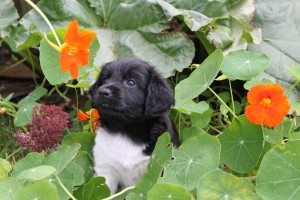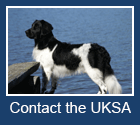UKSA Vice President, Janice Vittachi sets out why she believes we could learn a thing or two from nature when breeding.

Tynke: from the first UK born litter in summer 2013
We are all familiar with Charles Darwin’s theory of natural selection: healthy, successful animals thrive and ultimately pass their genes on while unhealthy, unsuccessful and (let’s face it) ugly animals do not. In this way, a population maintains its genetic health and integrity and a species is advanced.
Not all of us, however, are familiar with the theory of unnatural selection, which is when genetic traits are passed on (or not) due to factors outside of a population’s natural environment. A prime example would be the Asian Elephant, which is becoming a tuskless species of elephant due to the targeted hunting of ‘tuskers’ and subsequent loss of the tusk gene. Another example could be a big-ass meteor landing in the Gulf of Mexico.
Yet another method of selection is artificial selection. This is strikingly similar to unnatural selection, except that this one is a deliberate practice carried out by human beings. We’ve done it throughout much of our history for myriad reasons, perhaps most successfully for more efficient food production. But a frequent subject of our attention has been our pets and especially our dogs.
You may remember the BBC documentary Pedigree Dogs Exposed –a cautionary tale illuminating the dangers in breeding where aesthetics is a primary goal; the modus operandi of most of the world’s kennel clubs since the day they were formed. Among other things, the documentary highlighted some of the health issues of various breeds and some are quite disturbing. For instance, while we’ve all had a good laugh at the snorty whuffling breath of a pug, the fact is that this is a dog that cannot breathe – and we bred it that way on purpose! And then there are King Charles Cavalier Spaniels, which were developed (!) to have a skull which is too small to accommodate the brain, often causing a lifetime of pain. I’m willing to bet that all of us can name at least three breeds that we have made inherently and obviously unhealthy. To me, that’s appalling.
“Stabyhouns have been bred to be Dogs First and Foremost”
We’re very lucky that Stabyhouns have been bred to be Dogs First and Foremost. It is a healthy breed as a result. But the fact is that every earthly organism has strengths and weaknesses; every species has inherent health and illness. Each human being, for example, is the carrier of 10 to 20 hereditary diseases or disorders, ranging from the inconvenient to the devastating; from A to Z; asthma to zlotogora syndrome. Most dog breeds, on the other hand, carry only 5 hereditary conditions. So what’s the big deal? Why are humans healthy overall, while there are so many unhealthy dog breeds? The simple answer is: artificial selection. While we humans have allowed ourselves to breed willy-nilly, thereby minimising the impact of individual genes and ‘covering up’ recessive defects in a vast mix of genetic traits (natural selection), we have allowed only the ‘best’ of our dogs to breed. We’ve failed to recognise that by rejecting all but the best from the canine breeding pool we have effectively rejected genetic diversity.
Each attempt at the elimination of an ‘undesirable’ gene will affect many other genes for no reason other than that they reside on the same chromosomal strand.
To quote geneticist Dr Paul Mandigers: “We created the breeds. And we were sloppy.”
So how do we fix this? We now have a greater knowledge of genetics than we’ve ever had before, so maybe we can bring our understanding of the canine genome to bear. Indeed, these days there are many voices calling for genetic testing to be carried out on all breeding stock. The aim, obviously, is to prevent unhealthy dogs from passing on undesirable traits. On examination, however, it must be recognised that this is really just the high-tech version of what we’ve been doing all along: diminishing the gene pool. And if each dog is the carrier of several genetic disorders, then testing every dog for every probable condition will only have the unhelpful result of leaving us with no dogs to breed from at all!
No, screening and selection as a means to elimination is not the answer. In fact, any attempt we make to eliminate recessive genes will fail and may even make matters worse. Instead, we must focus on management. What works – and works well – is the simplest practice of all and can be summed up in four points…
“Make sure each pairing is unique and avoid risky matings”
1. Make sure that, in each generation, ample individuals are used for breeding
If only one puppy from a litter is used to continue that particular line, then 50% – yes, half! – of the unique genetic diversity produced by that pairing is permanently and irrevocably lost. If two puppies from that litter reproduce, then the loss is cut to 25%. Still more puppies mated preserves even more genetic diversity… and genetic diversity equals genetic health.
2. Make sure that each pairing is unique
Avoid breeding the same stud to the same bitch – regardless of how successful the match may have been. As we have already seen, each dog carries five genetic disorders regardless of how much care and consideration was put into the pairing of its sire and dam. By avoiding repeated stud/bitch combinations we ‘mix up’ the genetic pool and inhibit concentrations of any genetic trait, whether that trait be positive or negative. Again, genetic diversity equals genetic health.
3. Make sure that the animals bred from are healthy
Mental, sexual and behavioural health are to be considered as carefully as physical health. If an animal requires medical intervention to successfully mate or to be called healthy (except in the case of injury) then this animal should not be bred from. It is also important to make sure that the assessment is only made once the dog as fully matured.
4. Avoid risky matings
Mating a stud whose grand-sire had epilepsy to a bitch whose mother had the same disease is not wise, obviously. But do not eliminate a healthy stud from the gene pool simply because his grand-sire had epilepsy. Instead, pair that stud with an appropriate, low-risk bitch. “Cover up” the recessive gene without compromising genetic diversity.
These, put very simply, are the rough guidelines recommended by numerous geneticists to promote genetic health. And, interestingly enough, they approximate the ‘rules’ laid down by Mother Nature herself: “Use every animal in your breeding program,” she said a long time ago, “as long as they’re fit, healthy and not too ugly.”
Natural Selection. It’s worked for eons. Who are we to second-guess it?
Read more about the Breeding Rules for the Stabyhoun in the UK here.








